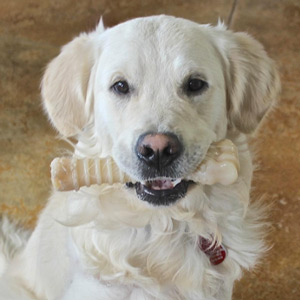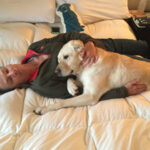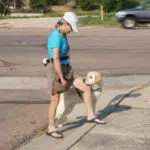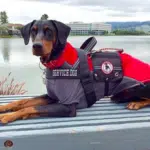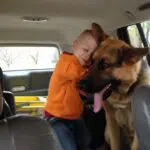Written by Alice Munley
How do we decide if our dog’s chew toy should be on its way to the trash barrel?
Let’s start with a short review of just some of the chew toys offered for sale across the country. There appears to be an unlimited number of possible chew toys available in the pet stores and on the Internet. I will focus on my own experiences and why I select certain chew toys. These are all my own personal opinions.
While I believe that any chew toy suitable for a big dog could be okay for a small dog, both the dog and owner may disagree. It really is a personal preference as chosen by you the dog owner and in the final analysis, the dog himself or herself. I’m assuming, of course, that the chew toy you would choose is large enough to be safe for your dog’s breed.
Young puppies seem to want to chew on the biggest bone they can manage to grab when they’ve been watching the big dogs chew away on them. I think that’s fairly typical of most little children who also want to do whatever big brother or big sister is doing, right? Once that tiny puppy can manage to stretch his little jaw wide enough to make contact on the bone with at least one tooth, he seems to think he has succeeded and becomes pretty proud of himself. At least that’s what I imagine he or she may be thinking. As difficult as it may be, they keep attempting to gnaw away on the bone but in a couple more weeks they’re managing to get more and more of that bone in their mouth. Success!
“All chew toys need supervision. As dog owners, we always need to be vigilant of the condition of each new and aging toy. Even the new toys can break when you don’t expect it.”
Through my experience of raising nearly 40 dogs over as many years, I have found that the chew toy(s) I introduce in those earliest days of puppyhood (8-9 weeks) will continue to be one of the dog’s favorites throughout his or her lifetime. I refrain from introducing little pups to plastic bottles, jugs, rags, or soft toys unless their breed has shown a soft mouth and no desire to tear up the soft toys. Of course there are always exceptions. A little puppy never forgets what they have been allowed to enjoy as a tiny pup. That’s for certain.
Many years ago, while traveling home after picking up our eight-week-old service dog puppy, we introduced her to a water bottle.
Seemed innocent enough, right? It was a long trip in the summer time. The puppy was curled up safely in a soft plush towel positioned into the bottom of the deep basket, sitting solidly on the car floor between the bucket seats. There wasn’t much room for anything like a water dish in the basket with the puppy, and we were only stopping for gas and potty breaks. Of course, a little puppy needs water. The easy answer to providing the needed water for this little puppy was from one of our water bottles. Truth is, that puppy loved the idea of getting her water straight from the bottle. It appeared to be a great answer for our 1000-mile drive home. The pup had no problems taking water from a dish, too, so the transfer over to food and water by dish was perfectly normal. It was several months after settling in with our newest pup at home that we discovered she now thought all similar bottles, be they water or pop, were fair game for her pleasure. That became an added lesson for this young pup and us. No bottles now, whatsoever!
My favorite dog toys are what I believe to be as safe as any dog toy can ever be.
All chew toys need supervision. As dog owners, we always need to be vigilant of the condition of each new and aging toy. Even the new toys can break when you don’t expect it. I’ve purchased toys that were meant for fetch and made of super tough fabric so they could not be torn apart easily and were triple stitched all over. For some dogs even those seemingly tough toys don’t last more than a few weeks before they get a puncture and begin to tear apart. Always remain watchful.
I will admit that through my own experience I have come to omit many chew toys, particularly the soft ones of all sizes. That’s a choice I make for my Labs and Goldens. Some Goldens can handle soft toys for a limited time—my Goldens are limited to a very short amount of time, so usually soft toys are not even a part of the collection in our house.
There is debate about dog toys,and again, that can be weighted by personal preference. I would emphasize however that safety should always be your No. 1 concern.
A personal experience:
Through an early experience and multiple reflections from others over the years, I have made the decision not to give any of my dogs chew items that are animal in origin, such as a pig’s ear, rawhides, antlers etc.
My basic reasoning for omitting this chews is grounded in my own personal observation from many years ago.
I was attending a group event with several young pups between the ages of 6-18 months and all their puppy raisers. A well-meaning puppy raiser introduced a few rawhide chews to this group of service puppies in training. These were all pups with sound breeding and very comfortable and accepting of each other, until the rawhides were introduced. There were many puppy raisers, including experienced adults, present with these pups, when all heck broke out over these rawhides. The adults took action immediately. The ruckus was stopped before it could escalate into an injury to any pup. The rawhides were removed and the pups all returned to their mellow selves.
“Again, bone likability for your dog is huge, but safety for your dog is most critical. Like kids, our pets may not choose the safest toy, but as the adults, it’s our job to make the right choice when the kids can’t do it themselves.”
For me that experience with the pups was a well-learned lesson.
I’ve seen other examples of similar scenarios and have heard stories from others of like reactions. While two or more dogs may easily (for the most part) share all other non-animal-based chews, my personal opinion is that the dogs are well aware of the difference in an animal-based chew. I’m certain with training this could be overcome within a controlled group of dogs, but it would take some serious training, and best done at a young age. There are other concerns I have with some animal-based chews, such as the rawhide. Some dogs seem to do just fine with them, while others can have serious complications after swallowing pieces. I would recommend that you do your own research on all the animal-based chews to determine for yourself if you want to purchase them for you dog—and always supervise.
While I’m not in a position to endorse any brand specifically, I do have some preferences.
However I must request readers to do your own research and read all labels carefully while taking a close visual overview of the toy. You know your pet better than anyone. Be honest with yourself, even if the toy is cute. It may not be the best choice. Don’t spend your hard-earned cash on something that you might need to throw away in a week or less.
I find, overall, that the Nylabone brand produces some of the toughest and longest lasting chew bones for my large-breed dogs. Not all Nylabones are equally tough, so choose carefully. Some of my favorites, because of their toughness and lasting ability are:
- Galileo – this is a monster bone great for all my tough chewers. (photo 1)
- Dura Chew (straight bone) is another favorite and they chew it down fast too. We have several on hand to replace as needed.
The BIG Dura-chew Power Durable for Large Breeds (knotted on each end) is one that lasts a little longer. (photo 2) - Dura Chew Textured Souper 10” style—also a good choice for those heavy chewers. (photo 3)
Many of the Nylabones come in a variety of sizes.
I always go for the biggest size due to my dogs’ chewing habits. There are bones specifically labeled for very large breeds as well. The largest Galileo bone can last for a year easily at my house when there are other chew bones available as well.
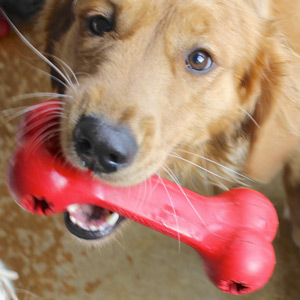

. . . and then offers it to Cam’O for a game of tug

Kongs are great and come in a variety of sizes and styles.
The original classic Kong can last forever if you don’t leave it outside for months and months. We have found the black holds up the best, but love the red too. I have no idea if the dogs even care. We also have tugs and bone-style Kongs.
Again, bone likability for your dog is huge, but safety for your dog is most critical. Like kids, our pets may not choose the safest toy, but as the adults, it’s our job to make the right choice when the kids can’t do it themselves.
A favorite chew toy is always a wonderful tool to help teach a puppy not to chew on your shoe, socks, or some other inappropriate item. Having several suitable chew toys located around your home or apartment helps make them readily available to quickly offer as an acceptable alternative to the shoe or table leg you catch them chewing on.
Try introducing a few ice cubes as a fun item to chew. Ice cubes make great treats too. I limit the number of ice cubes at any one time.
In conclusion, my suggestion is to try introducing a variety of safe and durable toys at the youngest age possible.
Remember that puppies have a great memory and will never forget what you allow them to chew at even the youngest age, like your old slipper, or an old sock with a hole in it, or an old shoe. They don’t know the difference between the old shoe and the new $200 pair.
Again, always monitor your dogs.
Wishing you safe and fun days with your puppy and all those fun toys you can purchase for him or her. Happy hunting and safe chewing!

